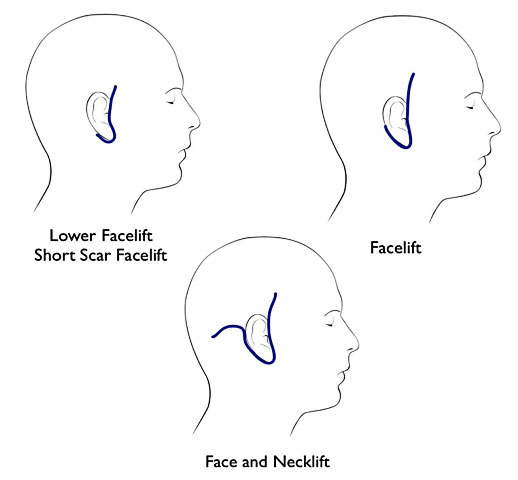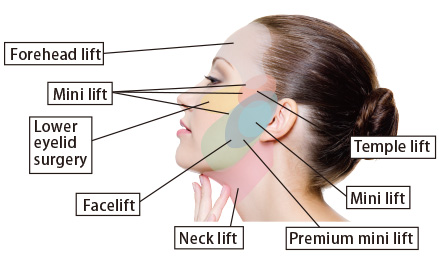Facelift in Iran
Facelift in Iran, also known as rhytidectomy, facelift, is one of the most popular procedures to reduce the signs of aging on the face. In this method, the surgeon removes the excess skin and lifts the underlying tissue to make the face look younger and more beautiful.
How to perform facelift in Iran
This procedure is usually performed under general anesthesia. By making incisions in the scalp and ears, the surgeon separates the skin and underlying tissue of the face. Then it lifts the underlying tissue and removes excess skin. Finally, he pulls the skin over the new tissue and secures the incisions with stitches.
Recovery after facelift in Iran
Full recovery from facelift in Iran may take several weeks or even months. After the operation, the face may be swollen and the skin may feel tight. These symptoms usually subside over several days or weeks.
Risks and complications of facelift surgery
Like any other surgery, face lift has its own risks and side effects. These complications can include infection, bleeding, some problems with anesthesia, swelling and bruising, inability to move facial muscles, and changes in skin color or appearance.
Please consult your doctor and inform him of all possible risks and complications before deciding to undergo this type of surgery. Having complete information can help you make a better decision.
If you want to operate in Tehran, Dr Hessami, click the button below and follow the stepsStart your therapeutic journey
COST OF FACE LIFT IN IRAN 2024
(deep face and neck lift surgery)
- The cost of facelift surgery in Tehran is between 2500 to 4000 euros
- Usually one night stay in the hospital is considered
- If you are not a resident of Tehran, the duration of stay in Tehran is 9 days
The cost of face and neck lift surgery |
2500 euros |
including surgeon + hospital fee | |
| Other costs related to face and neck lift surgery in Tehran | |||
| Cost of blood test | Between 10 and 15 euros | The difference depends on the type of blood test | |
| The cost of consultation with a cardiologist | Between 20 and 40 euros | For people over 40 or heart patients | |
| The cost of medicine and other health items | Between 10 and 20 euros | ||
| The cost of face and neck lift plastic surgery – optional | |||
| Nurse fee (per night) | 30 euros | If you are traveling alone | |
| The cost of changing the dressing by the nurse | |||
Attention:
- If you have an underlying disease or medication, let us know
- If you have already had facelift surgery, the cost of the surgery will increase slightly
- Let us know if you have anemia or other blood disorders
Procedures for facelift in Iran
Face lift surgery is a multi-step process that is generally as follows:
1. Initial Consultation: In this step, you meet with your surgeon to discuss your goals, expectations, and surgical options. Your surgeon may ask you to evaluate your condition through a physical exam, health history, and review of current medications.
2. Background of surgery: Before surgery, you should pay attention to your health, including stopping smoking (if applicable) and adjusting your medications. You may also need to prepare for the day of surgery, including arranging transportation and post-surgery care.
3. The day of the operation: On the day of the operation, you will most likely be under general anesthesia. The surgeon himself makes incisions in different parts of your face, changes the tissues under the skin, and then repositions and stitches the skin.
4. Recovery: After the operation, you will be transferred to the recovery unit and then to home or to the postoperative care center. Recovery may take several weeks or longer and includes management of swelling and bruising, wound care, and restriction of physical activity.
5. Post-operative visits: You will usually return to see your doctor several times after the operation to check the progress of your recovery. At this time, you can discuss any questions or concerns with your doctor.
What surgeries does full facelift in Iran include?
Full facelift in Iran may include several surgical procedures, all of which are performed with the goal of improving the overall appearance of the face. These methods include the following:
1. Forehead lift: In this procedure, the skin and tissue of the forehead is raised to reduce lines and wrinkles on the forehead and between the eyebrows.
2. Cheek lift: This operation is performed to restore the volume of fallen cheeks. In this surgery, fatty tissue is added to the cheeks or excess tissue is removed to change the shape of the cheeks.
3. Eye lift: In this procedure, excess skin and fatty tissue are removed from around the eyes. This will reduce eye bags and bags under the eyes.
4. Neck lift: This procedure is performed to remove wrinkles, excess fatty tissue and excess skin from the neck. It can also help to stretch the neck muscles.
5. Outpatient Facelift: In this surgery, the skin and underlying tissue of the face is pulled up to reduce wrinkles and skin sagging.
Each of these surgeries can be performed alone or combined with another to create a complete facelift. Choosing different methods depends on the specific needs and goals of each person.
Care after facelift in Iran
Aftercare after facelift in Iran can speed up your recovery and reduce the risk of complications. Below are several important points for care after such surgery:
1. Adequate rest: Adequate rest is very important in the first weeks after surgery. Try to sleep as much as possible during the day and avoid strenuous physical activities.
2. Maintenance of sutures: Sutures must be carefully cared for and protected to prevent infection and re-scarring. Your doctor may give you specific instructions on how to care for your stitches.
3. Proper nutrition: Eating nutritious foods can help you recover. Try to eat high fiber and protein foods.
4. Avoiding the sun: Your skin will be very sensitive after surgery, so avoid exposure to direct sunlight for long periods of time.
5. Taking prescribed medications: Your doctor may prescribe medications to reduce pain and prevent infection. Make sure you take the medication as directed by your doctor.
6. Regular visits to the doctor: Regular visits and follow-up examinations to the doctor are important to ensure proper recovery and prevent possible complications.
Any unusual or worrisome changes should be reported to your doctor immediately.
Recovery process after facelift in Iran
The recovery process after facelift in Iran is different and depends on the depth and extent of the surgery, the health status of the person and the body’s response to the surgery. But in general, the recovery process may be as follows:
First and second week:
– In these two weeks, swelling and bruising are common and gradually decrease.
– You should take care of your surgical bonuses and keep your head and neck in an elevated position to help reduce swelling.
– Most of the time, the stitches are removed about a week after the surgery.
Third to sixth week:
– Swelling and bruising are significantly reduced.
– You can start doing your normal daily activities, although you should still avoid heavy activities and vigorous exercise.
– You may feel sensitivity or itching in the surgical areas, but these symptoms will disappear gradually.
After six weeks:
Most of the side symptoms such as swelling and bruising should be completely or almost completely gone.
You should be able to return to vigorous physical activity.
The final results of surgery are beginning to show, although full recovery may take up to a year or more.
Types of cut lines in facelift in Iran
Facelift in Iran can be performed using several types of incision lines. The type of incision line used depends on the type and extent of facelift, clinical goals and surgeon’s preferences. Below you can see several types of common incision lines in face lift surgery:
1. Reductive Techniques: In these techniques, the surgeon makes an incision in the skin to access the tissues under the skin. After the desired changes have been made in the facial tissue, the excess skin is cut and reattached with stitches.
2. Mini Lifts: These types of lifts are usually performed with smaller incision lines and are mainly used to improve the appearance of certain parts of the face, such as the cheeks or chin.
3. SMAS Lift : In this technique, the surgeon makes an incision on the edge of the ear and around the ear towards the back hair. This allows the surgeon to access the SMAS (Superficial Musculo-Aponeurotic System) layer, which is a layer of fibrous tissue and muscles that connect the skin to the underlying tissues.
4. Deep Plane Lifts: These types of lifts usually have larger incision lines and allow the surgeon to access deeper facial tissues. This may lead to more permanent changes in facial appearance.

You should always discuss your surgical options with your doctor, including possible techniques, incision lines, and your expectations of results.
Suitable candidates for facelift in Iran
A suitable candidate for face lift surgery is a person who:
1. Is in good health: A facelift is a surgical procedure, and as such, the best candidates are those who are in good health. This includes not having heart disease, hypertension, diabetes, or other problems that may increase the side effects or risks of surgery.
2. Have realistic expectations of results: The best candidates are those who have a clear understanding of the possible outcomes of surgery. Facelift in Iran can improve the appearance of the face and reduce the signs of aging, but it cannot transform you into a different person or return you to the “younger version of you.”
3. The skin has good elasticity: One of the most effective factors in the success of facelift surgery is the elasticity and health of the skin. Skin with good elasticity responds better to surgery and leads to more natural results.
4. Does not smoke or is able to stop smoking: Smoking can hinder the healing process and increase the risk of complications. Therefore, the best candidates are people who do not smoke or are at least able to stop smoking while they are in treatment and recovery.
5. Prepare to meet the requirements of the recovery process: Facelift surgery can lead to a relatively long recovery period, which is likely to include swelling, bruising, wound healing, and limitations in daily activities. The best candidates are those who are ready for the course and are able to follow their doctor’s orders for recovery.
Remember that these are just some general criteria and the final decision should be made in consultation with a specialized surgeon.

